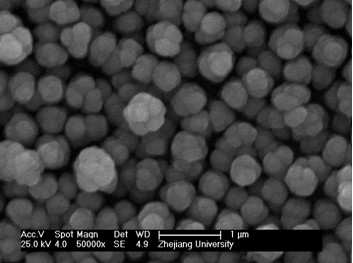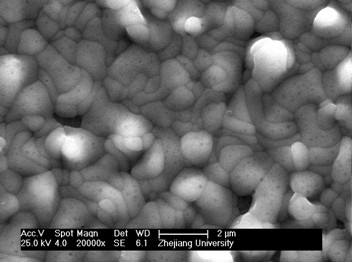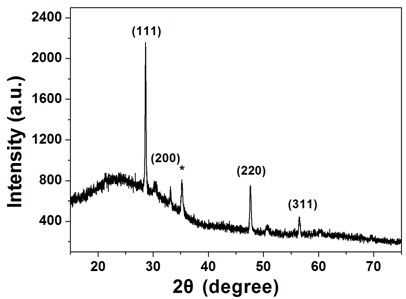Method for preparing NaYF4:Yb,ER up-conversion fluorescent material by adopting electro-deposition
A fluorescent material and electrodeposition technology, which is applied in the field of preparation of up-conversion fluorescent materials, can solve problems such as obstacles to universal application and complex equipment experiment procedures, and achieve the effects of simple equipment, fast deposition rate, and low growth temperature
- Summary
- Abstract
- Description
- Claims
- Application Information
AI Technical Summary
Problems solved by technology
Method used
Image
Examples
Embodiment 1
[0021] 1) Clean the ITO conductive glass twice with acetone, then clean the ITO conductive glass in an ultrasonic cleaner with deionized water for 10 minutes, then place the ITO conductive glass in 10% nitric acid solution to activate it for 10 seconds, and finally use Deionized water cleaning, stand-by;
[0022] 2) Add 0.03mol / L sodium ascorbate to the complex solution formed by 0.003mol / L disodium edetate and yttrium ion, ytterbium ion and bait ion with a molar ratio of 75:20:5, and then add 0.03 mol / L sodium fluoride solution, adjust the pH value to 5, and obtain the electrolyte solution for use;
[0023] 3) At 20°C, the ITO conductive glass is used as the working electrode, the platinum electrode is used as the counter electrode, and the saturated calomel electrode is used as the reference electrode to form a three-electrode system, which is placed in the electrolyte for electrodeposition. Compared with the saturated calomel electrode The deposition potential is 0.6V, and...
Embodiment 2
[0025] 1) Clean the ITO conductive glass with acetone for 3 times, then clean the ITO conductive glass in an ultrasonic cleaner with deionized water for 30 minutes, then place the ITO conductive glass in 10% nitric acid solution for 30 seconds, and finally use Deionized water cleaning, stand-by;
[0026] 2) Add 0.3mol / L sodium ascorbate to the complex solution formed by 0.3mol / L disodium edetate and yttrium ion, ytterbium ion and bait ion with a molar ratio of 94:5:1, and then add 0.6 mol / L sodium fluoride solution, adjust the pH value to 7, and obtain the electrolyte solution for use;
[0027] 3) At 80°C, the ITO conductive glass is used as the working electrode, the platinum electrode is used as the counter electrode, and the saturated calomel electrode is used as the reference electrode to form a three-electrode system, which is placed in the electrolyte for electrodeposition. Compared with the saturated calomel electrode The deposition potential is 1.5V, and the film prep...
Embodiment 3
[0029] 1) Clean the ITO conductive glass twice with acetone, then clean the ITO conductive glass in an ultrasonic cleaner with deionized water for 15 minutes, then place the ITO conductive glass in 10% nitric acid solution for 20 seconds, and finally use Deionized water cleaning, stand-by;
[0030] 2) To the complex solution formed by 0.01 mol / L disodium edetate and yttrium ion, ytterbium ion and bait ion with a molar ratio of 77:20:3, add 0.1 mol / L sodium ascorbate, and then add 0.1 mol / L sodium fluoride solution, adjust the pH value to 6, and obtain the electrolyte solution for use;
[0031] 3) At 50°C, the ITO conductive glass is used as the working electrode, the platinum electrode is used as the counter electrode, and the saturated calomel electrode is used as the reference electrode to form a three-electrode system, which is placed in the electrolyte for electrodeposition. Compared with the saturated calomel electrode The deposition potential is 0.8V, and the film prepa...
PUM
 Login to View More
Login to View More Abstract
Description
Claims
Application Information
 Login to View More
Login to View More - R&D Engineer
- R&D Manager
- IP Professional
- Industry Leading Data Capabilities
- Powerful AI technology
- Patent DNA Extraction
Browse by: Latest US Patents, China's latest patents, Technical Efficacy Thesaurus, Application Domain, Technology Topic, Popular Technical Reports.
© 2024 PatSnap. All rights reserved.Legal|Privacy policy|Modern Slavery Act Transparency Statement|Sitemap|About US| Contact US: help@patsnap.com










